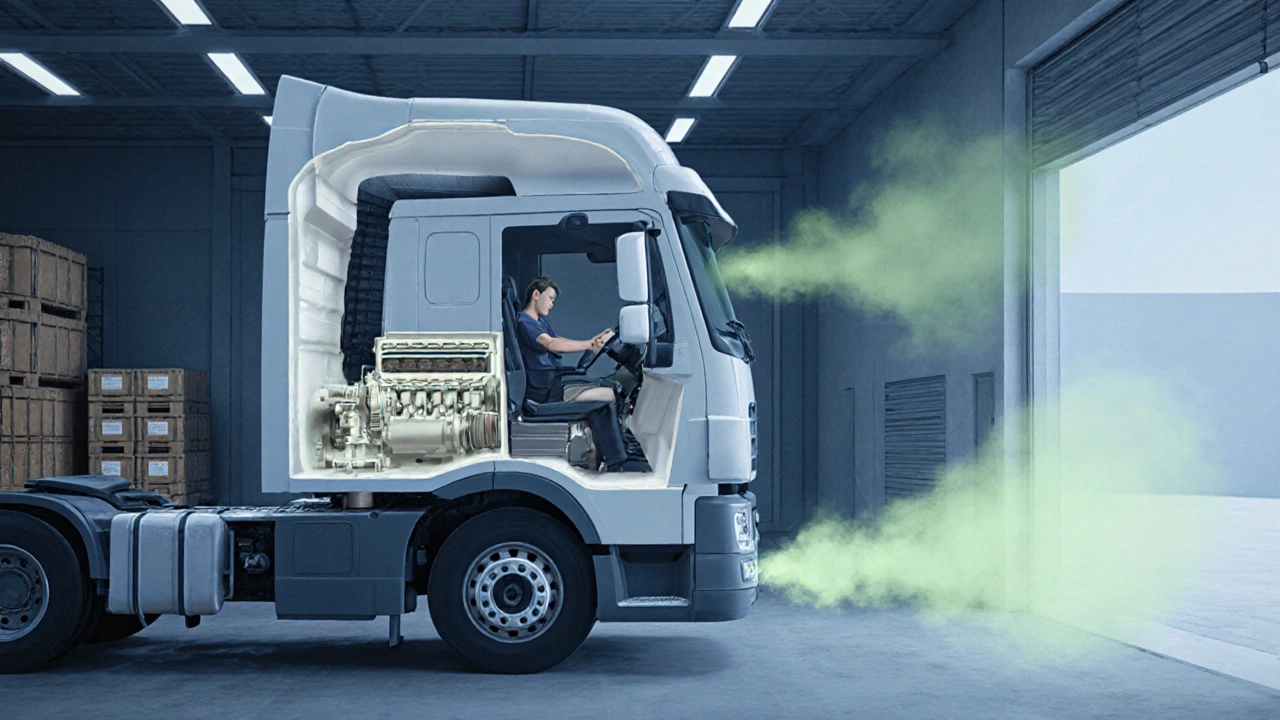Carbon Monoxide Exposure Risk Calculator
Driver Safety Assessment
Calculate carbon monoxide exposure risk when sleeping with engine idling
Risk Assessment Results
The short answer: truckers sometimes leave their engines running when they sleep, but it’s a choice weighed by comfort, safety, cost, and the law.
Why Drivers Might Idle Overnight
Long-haul drivers spend up to 14 hours behind the wheel each day. When they pull into a rest area or a truck‑stop parking lot, the cab becomes a makeshift bedroom. The sleeper cab is a compartment with a bed, climate control, and often a small fridge or microwave gives them a private space to rest.
- Heating or cooling - especially in winter or scorching summer - can be the difference between a good night’s sleep and a night of shivering or sweating.
- Power for devices - phones, GPS units, laptops, and even a small TV need electricity.
- Safety perception - many drivers feel safer with the engine running because it provides instant power for lights and horn, and it can deter potential thieves.
All of these reasons point to one common solution: keep the diesel engine idling.
How Idling Works in a Diesel Engine
A diesel engine converts fuel into mechanical energy by compressing air, injecting fuel, and igniting the mixture without a spark runs at a low RPM when idling, typically between 600‑800 revolutions per minute. This produces enough power to run the cab’s HVAC system, lights, and electronics, while consuming around 0.5‑0.8 gallons of fuel per hour depending on engine size and ambient temperature.
Safety Risks of Leaving the Engine Running
The biggest hidden danger is carbon monoxide a colorless, odorless gas produced by incomplete combustion of diesel fuel. In a well‑ventilated cab, the risk is low, but when a driver parks in a confined or partially enclosed space - such as a sheltered truck stop, a warehouse loading dock, or even next to a homeless shelter’s temporary shelter - exhaust can seep into the sleeping area.
- Symptoms of CO poisoning: headache, dizziness, nausea, and in severe cases, loss of consciousness.
- Fatal incidents are rare but documented; the National Highway Traffic Safety Administration (NHTSA) reports several dozen cases annually involving commercial vehicles.
- Modern trucks often include CO detectors, but older rigs may lack them.
Beyond health, an idling engine can attract attention from thieves, and the constant noise may disturb nearby residents, including those staying at homeless shelters.

Legal Landscape: Idling Regulations
In the United States, the Federal Motor Carrier Safety Administration (FMCSA) regulates commercial driver behavior, including hours‑of‑service rules does not directly ban idling, but many states have enacted specific limits:
- California: 5‑minute idle limit in most zones, 15‑minute limit at designated truck‑stop areas.
- New York: 10‑minute idle limit on public roads; unlimited idle in designated truck‑stop lots.
- Texas: No statewide limit, but local municipalities may enforce 30‑minute caps in urban areas.
The Environmental Protection Agency (EPA) sets national standards for vehicle emissions and encourages anti‑idling policies to reduce air pollution supports these state efforts, citing that idling trucks contribute significantly to nitrogen oxides (NOx) and particulate matter (PM2.5) in busy corridors.
Fuel Cost and Environmental Impact
Fuel expenses are a major line‑item for trucking companies. Idling for an 8‑hour sleep period can burn 4‑6 gallons of diesel, costing roughly $15‑$25 at current rates (2025 average $4.00 per gallon). Over a year, that adds up to $1,500‑$2,500 per driver.
Environmentally, each idle hour emits about 3.5 kg of CO₂. Multiply that by the millions of truck‑stop nights, and the carbon footprint becomes sizable. Reducing idle time not only saves money but also trims a driver’s personal contribution to climate change - a concern for many operators who already see pressure to adopt cleaner technologies.
Best Practices for Drivers
Most drivers adopt a blend of comfort and caution. Below are recommended steps:
- Use auxiliary power units (APUs): These small diesel‑powered generators run the cab’s systems while using 10‑20% of the fuel an idling main engine would consume.
- Invest in battery‑powered HVAC solutions: Modern systems can run off a high‑capacity battery for up to 12 hours.
- Park in well‑ventilated, designated truck‑stop bays: This reduces CO buildup and aligns with local idling ordinances.
- Install a carbon monoxide detector: Alerts the driver before dangerous levels develop.
- Follow local idle limits: Keep a log of where you park to avoid fines.

Implications for Homeless Shelters and Community Outreach
Many shelters, especially those operating near highways, sometimes see trucks parked overnight. While a sleeping driver can add a sense of safety, the idle exhaust may affect shelter residents, many of whom already have respiratory issues.
Community outreach programs can help by:
- Providing designated parking with proper ventilation for trucks.
- Offering education sessions for drivers about CO risks and local idling rules.
- Partnering with trucking companies to supply APUs or battery packs at discounted rates.
- Installing shared CO detectors in shelter parking lots to protect both drivers and residents.
These collaborations create a win‑win: drivers get safe, legal places to rest; shelters maintain a healthier environment for their guests.
Quick Checklist for Safe Overnight Parking
- ✅ Verify the location is a permitted parking area.
- ✅ Check ventilation - open windows or vents if the engine is idling.
- ✅ Use an APU or battery‑powered heater/AC when possible.
- ✅ Hang a CO detector inside the cab.
- ✅ Log idle time to stay within local limits.
- ✅ Respect shelter proximity - keep distance to avoid exhaust exposure.
Frequently Asked Questions
Do all truck drivers idle their engines when they sleep?
No. Many use auxiliary power units, battery‑powered climate control, or simply rely on the cab’s built‑in insulation to stay comfortable without idling.
How long can a diesel engine safely idle?
Legally, it depends on state or municipal rules - anywhere from 5 minutes to unlimited in designated truck‑stop zones. From a health standpoint, keep idle periods under 30 minutes when the cab isn’t well‑ventilated.
What are the fuel savings when using an APU instead of idling?
APUs typically consume 0.2‑0.4 gallons per hour, compared to 0.5‑0.8 gallons for engine idle. That’s up to a 50% reduction in fuel use during overnight stays.
Can an idling truck affect nearby homeless shelter residents?
Yes. Exhaust gases contain carbon monoxide and particulate matter, which can irritate respiratory conditions common among shelter occupants. Proper ventilation and distance mitigation are key.
What should a driver do if the CO detector sounds?
Turn off the engine immediately, open all doors and windows, and move the truck to a well‑ventilated area. Seek fresh air and, if symptoms persist, get medical help.
